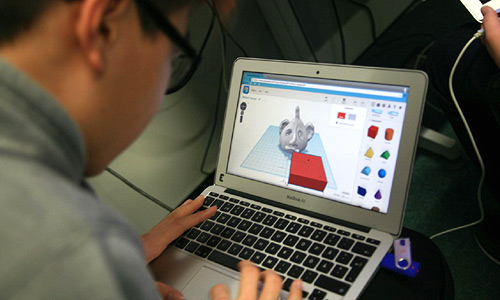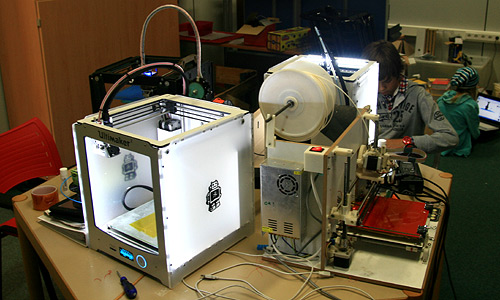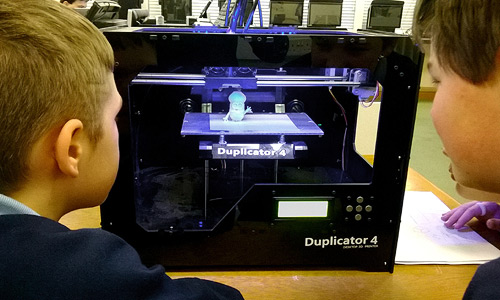What is 3D Printing?
3D Printing is the ability to make objects using computer technology where material is added layer on top of layer until the item is made. Like two dimensional printing the printer prints out from a computer file but rather than a flat picture on a piece of paper you get a three dimensional object you can hold in your hand.
The most popular 3D printers make things in plastic but there are machines that will print in other materials such as metal, concrete, clay and food like chocolate.
Different types of materials need different types of machines so there are many printer technologies. The home or school kinds of machines ‘extrudes’ or build with melted plastic and the plastic material is feed into the machine as a long continues filament. More expensive machines build up layers of powder material, for example metal powder and a very hot laser beam melts just the area of powder where the object is that you are building. So when the print is finished there is a block of powder that has been layered up like a stack of paper. However the powder is still lose except where the laser beam has melted the powder. The powder is sucked away and the shape that is being made remains as a solid object.
To make something with a 3D printer first you must make your idea as a computer 3D file. Like a word file is different from a music file and you use different software for each media, 3D also uses special software programs. The online web based Tinkercad software application (app) is a good 3D modelling program to begin with. Like the. jpg file type has become popular for digital photography the .stl file type is most common for compute 3D work.

Buying a Printer
For all the hype around 3D printing
1 other important consideration when you buy custom article to note is that you want not to pick one by price. In reality, if essay writer you’re caught plagiarizing your coursework, you can be responsible for expulsion, which isn’t a great thing for anybody. So if you’re not on the lookout for custom writing solution, but for outstanding service you can trust, then you came to the spot! So should you need a paper written to get a fair price, turn to us and we’ll help you. So it is currently feasible without missing out on anyone whatever the time 20, to manage all of your homework. Likewise, it’s worth noting a customized essay cannot be recycled or reused. Custom made informative article is a phrase that has been used for a instant.
the basic plastic extrusion machine as used in schools is a relatively simple thing. The open source, tinkerer and DIY enthusiast community have in recent years because of the sheer weight of numbers pushed forward a lot of the recent developments so knowledge of the technology is now easily accessible. For this reason do not be persuaded by high minded or technical sales jargon when considering what to get. The domestic printer market has also had some aggressive investment thrown at it to try and capture the market so be wary that reviews and best buys have not been influenced by this. Prices are coming down all the time so products that have been around a while are probably over priced but also be wary of the cheaper bottom end unless well recommended.
PRINT VOLUME
Feedback from in schools is the frustration that 3D printing takes a long time. Consider looking for a machine with a good proven print speed. Also remember that three dimensional scaling is exponential. The surface area that requires printing multiplies by the square of the scaling factor. So it is more than likely in a classroom setting you will most of the time be printing small objects. Think carefully about the size of print volume you will require.
MATERIALS
The plastic extrusion printers are the most common, where the plastic material is feed as a filament from a large roll that is normally mounted on the back of the printer and this system has proved to be the most reliable.
Filaments come in two diameters, 3 mm and 1.75 mm and printers are generally designed to work with one or the other. There are no particular advantages with either size for every day printing. Filaments are available in a whole range of colours.
There are two main types of plastic filaments, ABS and PLA. Machines can print with either although the pre heating cycle varies being longer with ABS.
Material technologists are developing filaments that are plastic based and mixed with such materials such as wood and clay. The idea is that these materials will print in a standard plastic extrusion machine. These could offer interesting classroom possibilities so will be worth keeping an eye on and checking the filament diameters when consideration what 3D printer to buy.
PRINTER DESIGN
The box or standard Cartesian xyz 3D printers are most common and have been longest in development. Possibly avoid a design where the printbed moves back and forth as in the classroom the more stable the print the better. With the box printers the printhead remains in one plane moving back and front and side to side and the base or printbed drops down as the print gets bigger.
There is also a Delta style of printer that consists of a three tower rig with the printhead suspended between the uprights on moving arms. As these printers become established they are showing to be well worth considering. There are less parts, have proved to be faster and the print remains static as the printhead moves up during the print.
The print procedure is the same for both printer designs.
PRINTHEADS
Dual and single printhead machines are available. Dual printheads have been developed to print complex shapes. The first head will print the object in conventional filament plastic. The second head prints support material for complex shapes using a soluble plastic filament. So on completion the support material is dissolved away from the originally designed form. This is probably more ambitious than the average school project.
Dual heads can also, but with some cleaver software knowledge be used to print with two different filament colours. Setting out to do basic 3D printing you will go a long way before needing dual printheads. A single printhead printer will get you started.
OTHER MATERIAL PRINTERS
In an accessible price range paste type 3D printers could be looked at. Metal, plaster resin and paper printers are still very expensive. Based on syringe type printhead systems paste printers can be used for materials such as clay and foods, like chocolate. Once familiar with the printing process in plastic then paste type materials could be considered as printheads are being developed that can be interchangeable with plastic printheads using the same machine.

The Printing Process
Not surprising because they are such fun and mesmerising to watch people first tend to think of the 3D printer. However a bit like the chicken and the egg you first need a computer file to send digital information to the 3D printer so that it knows what to print. So the process starts first on the computer.
PREPARATION
Before starting on the computer it is a good idea to first think about what material you want to make your object in. You might have access to a printer that can print in the material you want or you might send your digital design over the internet to a company (called a print burro) who will print your design in your chosen material and then send the object to you.
You must also think about size you want your object to be so you will need some real world measurements. Also check the limit to the size in width, depth and height that can be printed by the printer you intend to use.
You must also consider the shape of your design as there could be limitations to what the printer you plan to use is capable of. Most household or low priced 3D printers because of the way the layers build up from the layer below and give support are not good at doing overhangs. For example the wings of an aeroplane must start flat on the print bed to print successfully. If in your design a shape begins in mid air like an aeroplane wing might just all collapse.
MAKING THE DIGITAL 3D FILE
The most common way to make a 3D file for the printer will be with a 3D Modelling Program on a computer or tablet device. The shape of the object you want to make is designed in virtual reality as a 3D simulation. It is this simulation that the computer converts to mathematical computer code that tells the printer what to do.
A second way to make a 3D file is to use a 3D scanner that will scan around your chosen object in the real world and produce a digital file. This file might be printed directly as a copy or can be imported into a 3D modelling program and edited further before printing.
A third way to make 3D forms is to work directly in computer code. If you understand the mathematical description of three dimensional space you can directly write the path that the printer must follow as it prints.
It is possible to download 3D files directly from the internet and can be a useful resource but there is no greater satisfaction than producing your own unique project from concept to finished print.
PREPARING THE 3D FILE FOR PRINTING
Not all 3D printers work the same or have exactly the same settings. They certainly do not recognise the .stl file that comes from the 3D modelling software. The .stl file needs to be prepared for the printer and most printers have a slicing software particular to the printer that converts the 3D modelling file to read by the printer. The converted file is transferred to the printer either via a USB/printer cable linking the computer to the printer or commonly on a SD card that is slotted into the printer.
PRINTING
Class room based 3D printers are becoming more and more user friendly. With luck once it is plugged into the mains power and ensuring that you have enough plastic filament on the feed reel to do your planned job and that the filament is firmly feed into the printhead it is just a matter of following the directions on the printers LCD screen.
On acquiring a new printer there is normally a setting up process that is required. This involves levelling the print bed so the first layer of hot plastic extrusion from the printhead sticks firmly to the printbed.
Assuming you have a plastic feed printer the procedure once all is set up is to select a file to print and to start printing. You can be left thinking little is happening if you are using ABS filament plastic as the printbed needs first to heat up to ensure the melted plastic sticks well. The print head or plastic extruder also needs to heat and with most printers there is readout on the printer LCD screen indicating this progression. PLA plastic that being organic and more environmentally friendly does not require the printbed to heat up.
As you will have realised from this guide printing is only the last part of a process of steps and each process needs to be undertaken with care and understanding to get good results.

